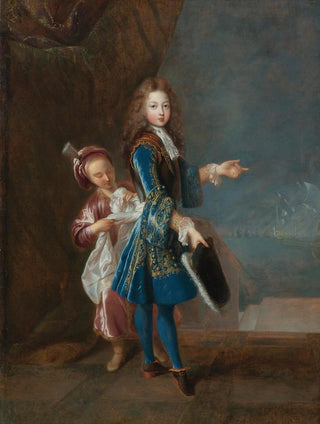Art print | Portrait of Louis Alexandre de Bourbon Count of Toulouse - Jean-François de Troy Source: Reproduction | Portrait of Louis Alexandre de Bourbon Comte de Toulouse - Jean-François de Troy


View from behind

Frame (optional)
Portrait of Louis Alexandre de Bourbon, Count of Toulouse - Jean-François de Troy – Engaging Introduction
The portrait of Louis Alexandre de Bourbon, Count of Toulouse, painted by Jean-François de Troy, is an iconic work that embodies the elegance and refinement of 18th-century French painting. Through this depiction, the viewer is transported into a universe where power and nobility intertwine with a carefully studied aesthetic. This painting, which captures both the grandeur and intimacy of its subject, bears witness to an era when art served the crown and aristocratic values. The art print of this masterpiece allows for a rediscovery not only of the historical figure Louis Alexandre was but also of the artist's genius who immortalized his essence.
Style and uniqueness of the work
Jean-François de Troy's style is characterized by an exceptional mastery of colors and meticulous attention to detail. In this portrait, the delicate nuances of the skin and the sumptuous drapery of Louis Alexandre's clothing are rendered with precision, giving the work an almost tactile dimension. The Count's gaze, both proud and contemplative, seems to tell a story— that of an influential man within the circles of French nobility. The subtly nuanced background highlights the subject without ever overpowering him, creating a perfect balance between the character and his environment. This stylistic choice reveals the artist's intention to establish an emotional connection between the viewer and the portraited.
The artist and his influence
Jean-François de Troy, court painter and recognized portraitist, managed to carve out a prominent place in the art world of the 18th century. Trained in the workshop of great masters, he developed a style that combines realism and idealization, captivating the elites of his time. His work is not limited to simple representations of figures but is part of an approach that values psychological traits and the personality of his subjects. de Troy's influence extends beyond his own production, inspiring many contemporary and future artists who sought to capture human essence through the prism of nobility. The art of de

Matte finish

View from behind

Frame (optional)
Portrait of Louis Alexandre de Bourbon, Count of Toulouse - Jean-François de Troy – Engaging Introduction
The portrait of Louis Alexandre de Bourbon, Count of Toulouse, painted by Jean-François de Troy, is an iconic work that embodies the elegance and refinement of 18th-century French painting. Through this depiction, the viewer is transported into a universe where power and nobility intertwine with a carefully studied aesthetic. This painting, which captures both the grandeur and intimacy of its subject, bears witness to an era when art served the crown and aristocratic values. The art print of this masterpiece allows for a rediscovery not only of the historical figure Louis Alexandre was but also of the artist's genius who immortalized his essence.
Style and uniqueness of the work
Jean-François de Troy's style is characterized by an exceptional mastery of colors and meticulous attention to detail. In this portrait, the delicate nuances of the skin and the sumptuous drapery of Louis Alexandre's clothing are rendered with precision, giving the work an almost tactile dimension. The Count's gaze, both proud and contemplative, seems to tell a story— that of an influential man within the circles of French nobility. The subtly nuanced background highlights the subject without ever overpowering him, creating a perfect balance between the character and his environment. This stylistic choice reveals the artist's intention to establish an emotional connection between the viewer and the portraited.
The artist and his influence
Jean-François de Troy, court painter and recognized portraitist, managed to carve out a prominent place in the art world of the 18th century. Trained in the workshop of great masters, he developed a style that combines realism and idealization, captivating the elites of his time. His work is not limited to simple representations of figures but is part of an approach that values psychological traits and the personality of his subjects. de Troy's influence extends beyond his own production, inspiring many contemporary and future artists who sought to capture human essence through the prism of nobility. The art of de






